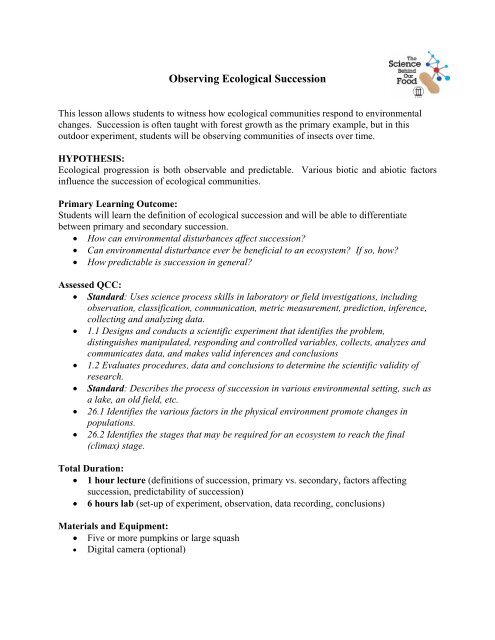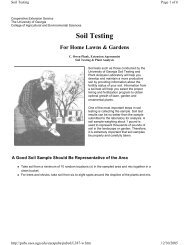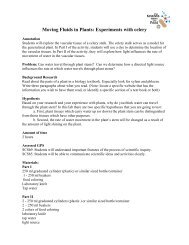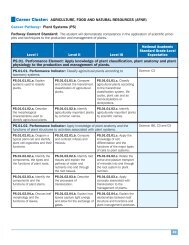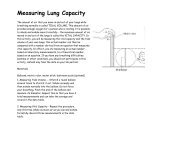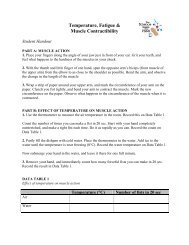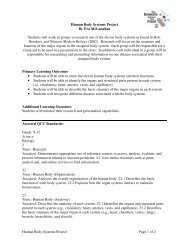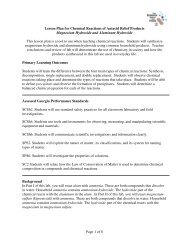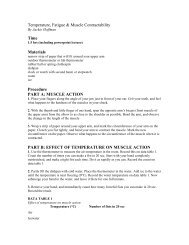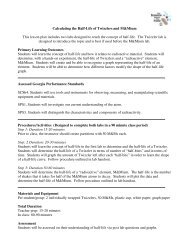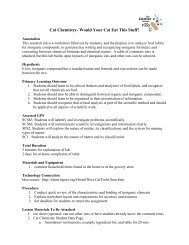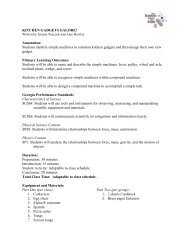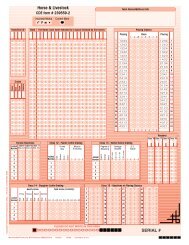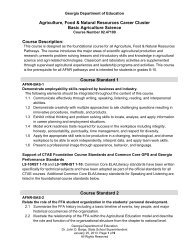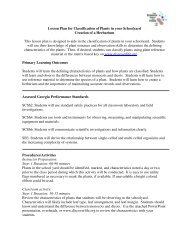Observing Ecological Succession
Observing Ecological Succession
Observing Ecological Succession
You also want an ePaper? Increase the reach of your titles
YUMPU automatically turns print PDFs into web optimized ePapers that Google loves.
<strong>Observing</strong> <strong>Ecological</strong> <strong>Succession</strong><br />
This lesson allows students to witness how ecological communities respond to environmental<br />
changes. <strong>Succession</strong> is often taught with forest growth as the primary example, but in this<br />
outdoor experiment, students will be observing communities of insects over time.<br />
HYPOTHESIS:<br />
<strong>Ecological</strong> progression is both observable and predictable. Various biotic and abiotic factors<br />
influence the succession of ecological communities.<br />
Primary Learning Outcome:<br />
Students will learn the definition of ecological succession and will be able to differentiate<br />
between primary and secondary succession.<br />
• How can environmental disturbances affect succession<br />
• Can environmental disturbance ever be beneficial to an ecosystem If so, how<br />
• How predictable is succession in general<br />
Assessed QCC:<br />
• Standard: Uses science process skills in laboratory or field investigations, including<br />
observation, classification, communication, metric measurement, prediction, inference,<br />
collecting and analyzing data.<br />
• 1.1 Designs and conducts a scientific experiment that identifies the problem,<br />
distinguishes manipulated, responding and controlled variables, collects, analyzes and<br />
communicates data, and makes valid inferences and conclusions<br />
• 1.2 Evaluates procedures, data and conclusions to determine the scientific validity of<br />
research.<br />
• Standard: Describes the process of succession in various environmental setting, such as<br />
a lake, an old field, etc.<br />
• 26.1 Identifies the various factors in the physical environment promote changes in<br />
populations.<br />
• 26.2 Identifies the stages that may be required for an ecosystem to reach the final<br />
(climax) stage.<br />
Total Duration:<br />
• 1 hour lecture (definitions of succession, primary vs. secondary, factors affecting<br />
succession, predictability of succession)<br />
• 6 hours lab (set-up of experiment, observation, data recording, conclusions)<br />
Materials and Equipment:<br />
• Five or more pumpkins or large squash<br />
• Digital camera (optional)
Procedures:<br />
Step One<br />
Cut the vegetables in half and place them outside, some in shaded areas, some in sunlight (if<br />
possible) and record preliminary observations, i.e., outdoor temperature, relative humidity, and<br />
rainfall. Students should also describe the initial condition of the squash, such as color, texture,<br />
and firmness.<br />
Step Two<br />
Observe the vegetables over a period of days or weeks. Record the number of different insect<br />
types present. Note any changes to the vegetable matter, and continue to record environmental<br />
data.<br />
• Describe the pioneer organism in this example.<br />
• How is the insect community changing<br />
• What are some ways in which the insect communities could be interacting<br />
• Why do different groups of insects appear at different times<br />
Assessment:<br />
Students can be quizzed or tested over the lecture and lab material. Extensive field notes should<br />
be taken and kept in a separate notebook. The notebooks should be as thorough as possible,<br />
describing the environmental conditions for each day, such as temperature, rainfall, and<br />
humidity. It may be useful for students to sketch the squash (or take digital photographs) so that<br />
changes over time can be documented.. Students should also be tested on the lecture material,<br />
with an emphasis on the definition of ecological succession as well as biotic and abiotic factors<br />
acting on a system.<br />
Extension:<br />
Students can design an experiment to test how the succession of organisms would differ under<br />
different environmental conditions. How do the results vary in warm weather vs. cool Would<br />
the experiment be affected by unusually heavy rainfall or drought


